By Steve Maricle.
In the second half of this two-part blog series (see part one, Canning Trout and Salmon: A Comprehensive Guide) we will discuss smoking fish.
Smoking preserves fish in two ways. First of all, the brining process uses salt to draw most of the water out of the flesh, effectively preserving the product through dehydration. Secondly, smoke is a natural preservative that has been used since Paleolithic times.
Preparation of Fish
For smoking salmon and trout, it’s important that the flesh be exposed, and thin enough to absorb the brine and properly dry. You can butterfly-cut the fish by cutting along the backbone through the length of the fish. Leaving the skin attached and intact along the length of the back allows the flesh on the two sides of the fish to be exposed to the brine when laying skin-side-down. Some anglers prefer to fully fillet the fish to remove all bones. For many salmon, the fillets are too thick and should be cut into smaller (about 500-gram) pieces, or scored/sliced into thinner layers to allow the salt to penetrate for proper curing.
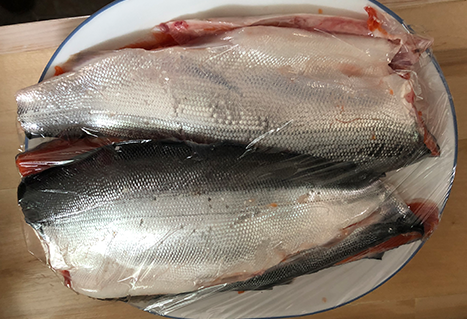
Brining Fish
The brining process is also used to infuse various flavours into the flesh. These flavours can range from spicy to sweet.
There are two types of brine: dry and wet.
Dry brines
Dry brines are normally the easiest to use. Start with a mixture of four parts of brown sugar to one part of non-iodized salt. You can add flavourings like lemon pepper, Montreal steak spice, ground ginger, garlic powder, or chili spices. Mix all the ingredients, and pour into a large, clean plastic container (like a peanut butter jar) with 3/8-inch holes drilled through the lid. Evenly shake the brining mixture onto the exposed fish flesh. Place the curing fish into a non-metallic tray or tub, cover with a clean cloth, and leave in a cool, dry place for up to 24 hours.
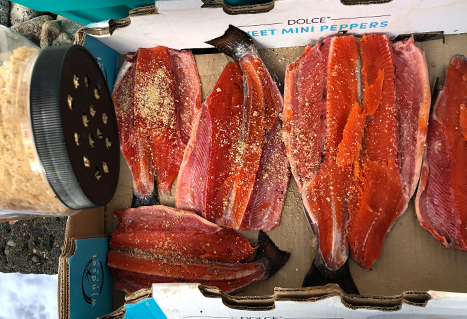
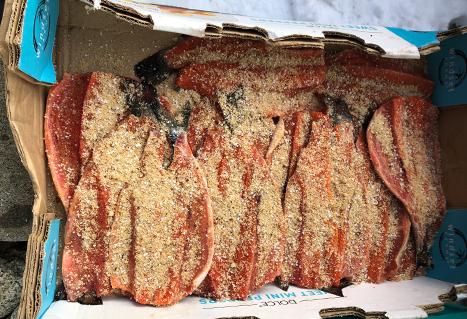
After brining, rinse the fish with cool water to remove any excess brining mixture, and pat dry. Place the fish onto smoking racks, and set them in a cool, breezy location to allow the surface of the flesh to “tack up” and not look visibly damp.
Wet brines
Wet brines are, as the name implies, liquid. The most basic brine uses one part each of non-iodized salt and brown sugar to every eight parts of warm water. Stir the solution until all the salt and sugar is dissolved, add your favourite flavourings, and then cool the solution in your refrigerator before using. Place your fish into a non-metallic container, and make sure the brining solution completely submerges the fish. Cover the container, and allow the fish to brine for 12 to 24 hours in a cool place. Lightly rinse off brined fish with cold water before placing them on smoking racks.
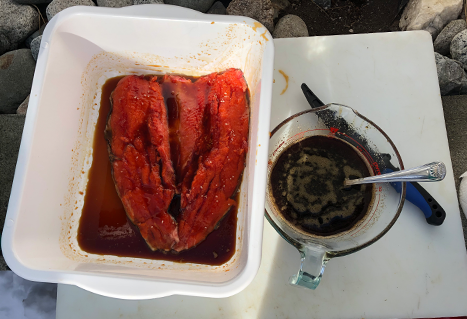
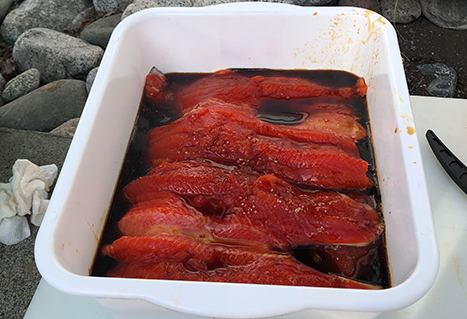
One of my new favourites is a mixture of 125 ml (1/2 cup) of soya sauce and 60 ml (1/4 cup) of maple syrup for each 500 grams (pound) of salmon, which creates a “salmon candy” flavouring. Using a non-metallic container, make sure the fish is totally submerged in the wet brine, and then leave it in a cool place for 24 hours. This allows both the extraction of moisture from the flesh, and the soya-maple infusion to replace it. Once the brining process is completed, the fish can be placed onto the smoker trays without rinsing.
Methods of Smoking
Fish can be smoked using a hot or cold smoke.
Hot smoking
Hot smoking is the simplest and most widely used method. The process commonly uses an electric heating element located directly underneath the racks of brined fish. A metal pan full of aromatic wood chips is placed onto the heating element. The wood chips will slowly smoulder to provide the smoke that cures the fish. As the temperature is fairly high — 52° to 80°C (126° to 176°F) in the proximity of the heating element — the fish will be slowly cooked during the eight- to 12-hour smoking process, and the final product will be flakier and opaque, like baked fish, as a result.
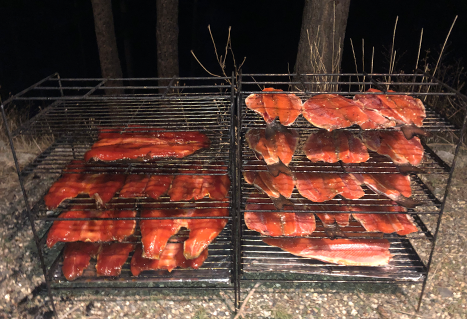
There are several recreational hot smokers (like the Luhr Jensen Little Chief) available on the market. They are typically an aluminum box which contains a metal rack that holds four or six trays, with a heating element and wood-chip pan on the bottom. More automated (and expensive) smokers (like the Bradley Smoker) utilize pucks of pre-pressed wood chips that are placed in a stacker and automatically fed onto the heating element.
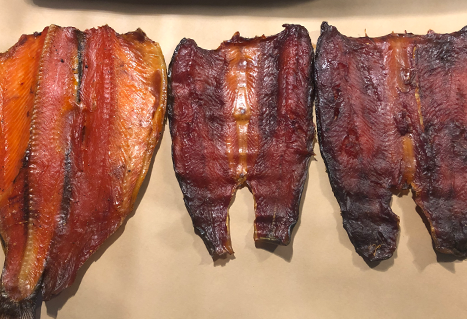
Cold smoking
Cold smoking produces a much different final product. The cold-smoke method involves having the heating element and wood chips housed in a separate smoke-generating unit from the racked fish. A system of pipes connecting the two units allows the smoke to cool to between 20° and 30°C (68° to 86°F) as it travels into the fish unit. Since the smoke is lower in temperature by the time it reaches the fish, the final product will retain a flesh-like consistency and more translucent appearance. The smoked fish can be cut into extremely thin slices, with a silky rather than flaky texture. Cold-smoked fish is generally considered a higher quality product.
Wood chips can be purchased or made yourself. Aromatic hardwoods (like oak, alder, apple, and cherry) are best for smoking fish.
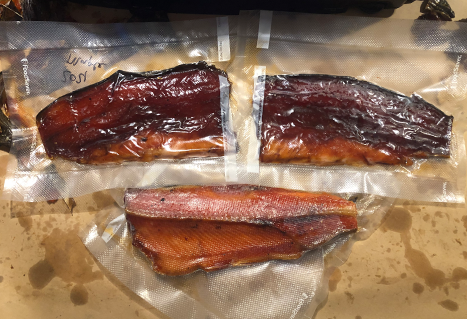
Smoking Tips
- If you prefer a drier final product, place the rack with the smoker trays in a cool, dry area and place a fan in front of the rack. The fan will further dry the flesh out prior to smoking. The drier the flesh, the more translucent and silkier the final product.
- I like to use the kind of short boxes/trays that are used to ship produce. You can pick these up at Costco. Lay the fish skin-side-down on the cardboard. Once you have a single layer down, simply sprinkle the dry brine onto the flesh. The brine does not have to be overly thick, but ensure that all parts of each fish are covered. If you are smoking many fish, you can stack another layer or two of fish, sprinkling the brine on each layer.
- Once the brine is applied to all the fish, place a piece of parchment or wax paper on top of the fish. Next, take a large plastic bag and slide the full tray into the bag. This bag contains all the brine and moisture that results from the process. Leave the fish to brine in a cool area between 12 and 24 hours.
- It’s best to do your fish-smoking when outside temperatures are cool. This will allow you to brine, fan-dry, and smoke the fish for longer periods of time, thus achieving a more desirable, smokier product.
- Alder, apple, oak, or cherry limbs can be cut into small rounds rather than chipped. The dried rounds placed into the smoking pot will provide ample smoke, and are easier to handle.
- Apply three pots of chips for each batch of fish you smoke. Discard the burnt chips into a bucket of water, and add new chips every 1.5 hours.
- To achieve the best results whether smoking or canning, start with your best fish. Frozen trout and salmon are perfectly acceptable provided they haven’t suffered freezer burn.
- Get the best of both worlds: lightly smoke and then can your fish for a unique, tasty treat.
- Brining and cold smoking will not kill roundworms or tapeworms that salmon and trout may harbour. Freeze fish for a week or more at -20°C (-4°F) to eradicate these parasites.
- Cold-smoking fish will not eliminate the bacterium Clostridium botulinim, which produces the toxin in botulism poisoning. Vacuum-packaging can create the perfect anaerobic (oxygen-free) environment for this organism to thrive and reproduce. Fortunately, freezing temperatures will prevent this from happening. Immediately deep-freeze any cold-smoked fish as soon as possible after vacuum packaging. Later, when thawing the smoked fish, cut the bag open: allowing oxygen in will prevent this organism from reproducing.
Author: Steve Maricle
Images: Steve Maricle
Steve Maricle is a fly fishing guide based in Kamloops, British Columbia.
Follow Steve on Instagram or visit his website: Maricle Consulting and Fly Fishing Adventures.